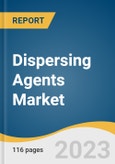The global dispersing agents market size is expected to reach USD 8.49 billion by 2030, expanding at a CAGR of 5.9% from 2023 to 2030. Dispersing agents, also known as dispersants, are chemical additives that play a crucial role in various industries. They are used to facilitate the dispersion of solid particles or immiscible liquids in a liquid medium, creating stable and homogeneous mixtures. The primary function of the product is to reduce the forces of attraction between particles, preventing them from clumping together and ensuring uniform distribution.
In various industries, achieving proper dispersion is crucial for ensuring that products perform optimally. By effectively dispersing ingredients in formulations, the product enhances properties like stability, rheology, color development, and overall quality. Dispersing agents are especially important in industries such as paints and coatings, adhesives, inks, construction, ceramics, pharmaceuticals, and personal care products. For instance, in the paint and coatings industry, dispersing agents are essential for maintaining consistent color, preventing pigment settling, and ensuring uniform film formation. In the pharmaceutical industry, they are utilized to improve the bioavailability of active pharmaceutical ingredients.
However, a wide range of dispersants are offered by specialty chemical manufacturers in the market. The synthesis of dispersants requires various chemicals as feedstock. Their formulation not only requires complex chemical formulation but also necessitates the procurement of raw materials from various different suppliers. Various raw materials, such as ethylene glycol, glycol ethers, polyethylene glycol, benzalkonium chloride, sulfosuccinate esters, and oxyalkylated c12-c15 alcohols among others, are used in the processing of a wide variety of dispersion agents. One of the major challenges faced by the manufacturers of the product is the sourcing of raw materials with volatile prices. Fluctuating prices of raw materials is a key restraint for the product manufacturers for the large-scale production of dispersants and the production of tailor-made solutions to suit the requirements of customers.
In various industries, achieving proper dispersion is crucial for ensuring that products perform optimally. By effectively dispersing ingredients in formulations, the product enhances properties like stability, rheology, color development, and overall quality. Dispersing agents are especially important in industries such as paints and coatings, adhesives, inks, construction, ceramics, pharmaceuticals, and personal care products. For instance, in the paint and coatings industry, dispersing agents are essential for maintaining consistent color, preventing pigment settling, and ensuring uniform film formation. In the pharmaceutical industry, they are utilized to improve the bioavailability of active pharmaceutical ingredients.
However, a wide range of dispersants are offered by specialty chemical manufacturers in the market. The synthesis of dispersants requires various chemicals as feedstock. Their formulation not only requires complex chemical formulation but also necessitates the procurement of raw materials from various different suppliers. Various raw materials, such as ethylene glycol, glycol ethers, polyethylene glycol, benzalkonium chloride, sulfosuccinate esters, and oxyalkylated c12-c15 alcohols among others, are used in the processing of a wide variety of dispersion agents. One of the major challenges faced by the manufacturers of the product is the sourcing of raw materials with volatile prices. Fluctuating prices of raw materials is a key restraint for the product manufacturers for the large-scale production of dispersants and the production of tailor-made solutions to suit the requirements of customers.
Dispersing Agents Market Report Highlights
- The market is anticipated to witness growth with a CAGR of 5.9% from 2023 to 2030. This is attributed to the advancing demand for the product from construction and paints, coatings, & ink industries worldwide
- Water-borne in type segment emerged as the fastest growing type with a CAGR of 5.9% from 2023 to 2030. This growth is attributed to its ability to achieve uniform dispersion and stability of the particles while ensuring optimal performance of the final product
- Anionic in structure segment emerged as the fastest growing with a CAGR of 6.3% from 2023 to 2030. The growth of this segment can be attributed to the ability of anionic dispersing agents to enhance the color strength, rheological properties, and stability of the final product. They are often used in combination with other additives, such as defoamers, wetting agents, or rheology modifiers, to achieve the desired performance
- Personal care & cosmetics in end-use segment is anticipated to witness growth with a CAGR of 5.6% from 2023 to 2030. The growth is attributed to the fact that these agents help break down pigment agglomerates, ensuring even distribution and vibrant color payoff in cosmetic products such as foundations, eyeshadows, lipsticks, and nail polishes
- Europe region is anticipated to witness growth with a CAGR of 6.4% from 2023 to 2030. This growth is attributed to the presence of dispersing agent manufacturers, such as BASF SE, Arkema SA, Solvay S.A., Altana AG, Evonik Industries AG, and Uniqchem, among others, coupled with the significant growth of end-use industries including food & beverages, adhesives, paints & coatings, and construction in the region.
Table of Contents
Chapter 1 Methodology and Scope
Chapter 2 Executive Summary
Chapter 3 Dispersing Agents: Market Variables, Trends & Scope
Chapter 4 Dispersing Agents Market: Supplier Portfolio Analysis
Chapter 5 Dispersing Agents Market: Type Estimates & Trend Analysis
Chapter 6 Dispersing Agents Market: Structure Estimates & Trend Analysis
Chapter 7 Dispersing Agents Market: Regional Estimates & Trend Analysis
Chapter 8 Dispersing Agents Market: End-Use Estimates & Trend Analysis
Chapter 9 Competitive Landscape
List of Tables
List of Figures
Companies Mentioned
- BASF SE
- Arkema
- Kemira
- Solvay S.A.
- Altana AG
- Dow
- Evonik Industries AG
- Clariant
- Uniqchem
- Rudolf GmbH
- The Lubrizol Corporation
- Italmatch CSP
- Nouryon
Methodology

LOADING...
Table Information
| Report Attribute | Details |
|---|---|
| No. of Pages | 116 |
| Published | September 2023 |
| Forecast Period | 2022 - 2030 |
| Estimated Market Value ( USD | $ 5.37 Billion |
| Forecasted Market Value ( USD | $ 8.49 Billion |
| Compound Annual Growth Rate | 5.9% |
| Regions Covered | Global |
| No. of Companies Mentioned | 13 |









